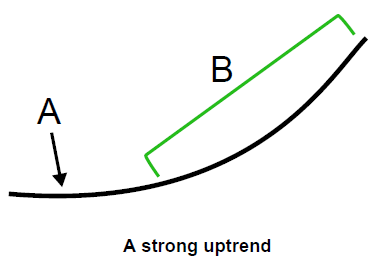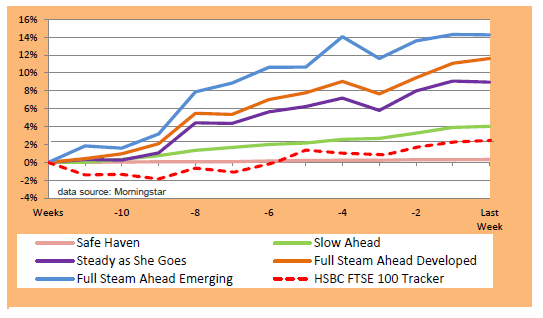Let’s look at what happens when a market starts to trend upwards.

As the market starts to rise (point A), the upward gradient of the slope starts to increase.
As we know, the more volatile sectors will exaggerate this upward movement, and the less volatile sectors will dampen it.
The more the gradient of the upward slope increases, the more pronounced this difference between the sectors becomes. So as the upward slope gets steeper and steeper (B), the most volatile sectors will be outperforming the least volatile ones by a greater and greater degree.
If we took a snapshot of the performance of the various Saltydog groups in the latter part of stage B, it would look like this:

Strong uptrend: the most volatile sectors significantly out-perform the least volatile ones
In this instance of a strongly rising market, the most volatile group - Full Steam Ahead, Emerging Markets (the blue line) - is storming ahead. It has produced a 14% gain in just 12 weeks.
But at the other end of the scale, the least volatile groups – Safe Haven (pink line) and Slow Ahead (green line) - have only gone up by about zero and 4% respectively, over the same period.
In other words, the most volatile group is outperforming the least volatile groups by at least 3x. That’s a huge difference.
In this kind of situation we want to maximise our gains, and we do this by increasing our exposure to the more volatile sectors. In other words, we put more of our money into funds in these sectors.
Let me re-emphasise: this is a key feature of the Saltydog method, and completely different from passive, buy-and-hold investing. In other words, we’re not just sitting and watching the market. Instead we’re picking the best sectors to be in at any particular time, week by week.
Now there is the important question of how much risk you personally want to take on. And it’s entirely up to you how far you want to increase your exposure to the more volatile sectors.
If you’re a cautious investor, in this uptrend situation you probably want only a small additional exposure to the more volatile sectors of the market – leaving most of your money in the safer, less volatile sectors. On the other hand, if you’re a more adventurous investor, you will want a much bigger exposure to the more volatile sectors.
It’s your choice. This question is covered in Part 1, Chapter 14. (See Cautious or adventurous? Deciding how much risk you want to take). It’s very straightforward, and we have set up some simple rules for you to follow, depending on how cautious or adventurous you want to be.
Either way, whatever sort of investor you are, the key points remains the same:
- When the market is trending upwards, the more volatile sectors will start to outperform the less volatile sectors.
- In this situation, to increase your gains, you want to increase your exposure to the more volatile sectors.
Read next > What happens when the market flattens off?

Comments
0 comments
Please sign in to leave a comment.